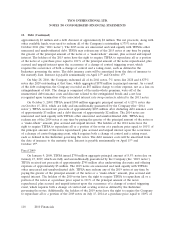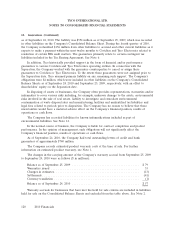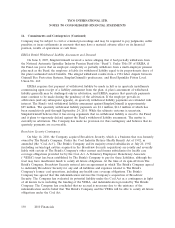ADT 2010 Annual Report Download - page 211
Download and view the complete annual report
Please find page 211 of the 2010 ADT annual report below. You can navigate through the pages in the report by either clicking on the pages listed below, or by using the keyword search tool below to find specific information within the annual report.TYCO INTERNATIONAL LTD.
NOTES TO CONSOLIDATED FINANCIAL STATEMENTS
13. Financial Instruments (Continued)
Counterparty Credit Risk
The use of derivative financial instruments exposes the Company to counterparty credit risk. If the
counterparty fails to perform, the Company is exposed to losses if the derivative is in an asset position.
When the fair value of a derivative instrument is an asset, the counterparty has to pay the Company to
settle the contract. This exposes the Company to credit risk. However, when the fair value of a
derivative instrument is a liability, the Company has to pay the counterparty to settle the contract and
therefore there is no counterparty credit risk. Tyco has established policies and procedures to limit the
potential for counterparty credit risk, including establishing limits for credit exposure and continually
assessing the creditworthiness of counterparties. As a matter of practice, the Company deals with major
banks worldwide having long-term Standard & Poor’s and Moody’s credit ratings of Aǁ/A3 or higher.
To further reduce the risk of loss, the Company generally enters into International Swaps and
Derivatives Association master agreements with substantially all of its counterparties. Master netting
agreements provide protection in bankruptcy in certain circumstances and, in some cases, enable
receivables and payables with the same counterparty to be offset on the Consolidated Balance Sheets,
providing for a more meaningful balance sheet presentation of credit exposure. The Company’s
derivative contracts do not contain any credit risk related contingent features and do not require
collateral or other security to be furnished by the Company or the counterparties.
The Company’s exposure to credit risk associated with its derivative instruments is measured on an
individual counterparty basis, as well as by groups of counterparties that share similar attributes. As of
September 24, 2010, the Company was exposed to industry concentration with financial institutions as
well as risk of loss if an individual counterparty or issuer failed to perform its obligations under
contractual terms. The maximum amount of loss that the Company would incur as of September 24,
2010 without giving consideration to the effects of legally enforceable master netting agreements, was
approximately $66 million.
Fair Value of Financial Instruments
Authoritative guidance for fair value measurements establishes a three-level hierarchy that ranks
the quality and reliability of information used in developing fair value estimates. The hierarchy gives
the highest priority to quoted prices in active markets and the lowest priority to unobservable data. In
cases where two or more levels of inputs are used to determine fair value, a financial instrument’s level
is determined based on the lowest level input that is considered significant to the fair value
measurement in its entirety. The three levels of the fair value hierarchy are summarized as follows:
• Level 1—inputs are based upon quoted prices (unadjusted) in active markets for identical assets
or liabilities which are accessible as of the measurement date.
• Level 2—inputs are based upon quoted prices for similar assets or liabilities in active markets,
quoted prices for identical or similar assets or liabilities in markets that are not active, and
model-derived valuations for the asset or liability that are derived principally from or
corroborated by market data for which the primary inputs are observable, including forward
interest rates, yield curves, credit risk and exchange rates.
• Level 3—inputs for the valuations are unobservable and are based on management’s estimates of
assumptions that market participants would use in pricing the asset or liability. The fair values
are therefore determined using model-based techniques such as option pricing models and
discounted cash flow models.
2010 Financials 123
























